
Catherine Cranston
Encyclopedia
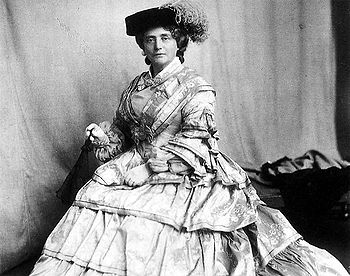
Charles Rennie Mackintosh
Charles Rennie Mackintosh was a Scottish architect, designer, watercolourist and artist. He was a designer in the Arts and Crafts movement and also the main representative of Art Nouveau in the United Kingdom. He had a considerable influence on European design...
and Margaret MacDonald
Margaret MacDonald (artist)
Margaret MacDonald Mackintosh was a Scottish artist whose design work became one of the defining features of the "Glasgow Style" during the 1890s....
, in Glasgow
Glasgow
Glasgow is the largest city in Scotland and third most populous in the United Kingdom. The city is situated on the River Clyde in the country's west central lowlands...
, Scotland
Scotland
Scotland is a country that is part of the United Kingdom. Occupying the northern third of the island of Great Britain, it shares a border with England to the south and is bounded by the North Sea to the east, the Atlantic Ocean to the north and west, and the North Channel and Irish Sea to the...
. The name of Miss Cranston's Tea Rooms lives on in reminiscences of Glasgow in its heyday.
Background
Her father, George Cranston, was a baker and pastry maker and, in 1849, the year of her birth, he became proprietor of the Edinburgh and Glasgow RailwayEdinburgh and Glasgow Railway
The Edinburgh and Glasgow Railway was a railway built to link Glasgow and Edinburgh. The Act of Parliament for building the railway received its Royal Assent in 1838 which was open on 28 July 1863. Services started between Glasgow Queen Street and Haymarket on 21 February 1842. The line was...
Chop House and Commercial Lodgings at No. 39 George Square in Glasgow city centre. The hotel
Hotel
A hotel is an establishment that provides paid lodging on a short-term basis. The provision of basic accommodation, in times past, consisting only of a room with a bed, a cupboard, a small table and a washstand has largely been replaced by rooms with modern facilities, including en-suite bathrooms...
was renamed the Royal Horse, then renamed again in May 1852 to become Cranston's Hotel and Dining Rooms, offering:
- "Convenient Coffee room and detached Smoking Rooms on Ground Floor, commodious Commercial Room and Parlour, comfortable Bed-rooms and Baths, &c. Coffee always ready. Cigars, wines, spirits, ales, Newspapers, Time-Tables, Writing Materials. Superior and varied Bill of Fare at the usual moderate charges.
Her slightly older brother Stuart (1848–1921) became a tea dealer and, according to Glasgow in 1901, was "a pioneer of the business" there of "tea shops pure and simple" who by 1901 had three such tearooms offering nothing more substantial to eat than a sandwich. Kate went on to create much more of a social facility.
Like other cities in the United Kingdom
United Kingdom
The United Kingdom of Great Britain and Northern IrelandIn the United Kingdom and Dependencies, other languages have been officially recognised as legitimate autochthonous languages under the European Charter for Regional or Minority Languages...
, Glasgow was then a centre of the temperance movement
Temperance movement
A temperance movement is a social movement urging reduced use of alcoholic beverages. Temperance movements may criticize excessive alcohol use, promote complete abstinence , or pressure the government to enact anti-alcohol legislation or complete prohibition of alcohol.-Temperance movement by...
which sought an alternative to male-centred pubs. Tea had previously been a luxury for the rich, but from the 1830s it was promoted as an alternative to alcoholic drinks, and many new cafés and coffee houses were opened, catering more for ordinary people. However it was not until the 1880s that tea rooms and tea shops became popular and fashionable.
Miss Cranston's Tea Rooms
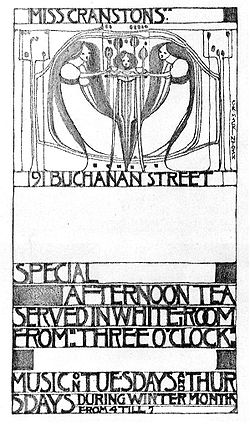
Argyle Street, Glasgow
Argyle Street is a major thoroughfare in the city centre of Glasgow, Scotland.With Buchanan Street and Sauchiehall Street, Argyle Street forms the main shopping artery in the city centre...
. She set high standards of service, food quality and cleanliness, and her innovation lay in seeing the social need for something more than a restaurant
Restaurant
A restaurant is an establishment which prepares and serves food and drink to customers in return for money. Meals are generally served and eaten on premises, but many restaurants also offer take-out and food delivery services...
or a simple "tea shop", and in putting equal attention into providing amenities designed in the latest style. Her first tearoom was decorated in a contemporary baronial style. On 16 September 1886 she opened her Ingram Street tearoom and in 1888 commissioned George Walton
George Henry Walton
George Henry Walton , was a noted Scottish architect and designer of remarkable diversity. George was the youngest of twelve talented children of Jackson Walton, a Manchester commission agent and himself an accomplished painter and photographer, by his second wife, the Aberdeen-born Quaker Eliza...
to decorate a new smoking room in the Arts and Crafts style
Arts and Crafts movement
Arts and Crafts was an international design philosophy that originated in England and flourished between 1860 and 1910 , continuing its influence until the 1930s...
in one of her tea rooms.
In 1892 she became happily married to John Cochrane, but continued to trade under the name of Miss Cranston's Tearooms. She opened new tearooms in Buchanan Street in 1897, expanded to take over the whole building in Argyle Street by 1898, then completed her chain of four establishments with the Willow Tearooms
Willow Tearooms
The Willow Tearooms are tearooms at 217 Sauchiehall Street, Glasgow, Scotland, designed by internationally renowned architect Charles Rennie Mackintosh, which opened for business in October 1903...
in Sauchiehall Street
Sauchiehall Street
Sauchiehall Street is one of the main shopping/business streets in the city centre of Glasgow, Scotland. Along with Buchanan Street and Argyle Street, it forms the main shopping area of Glasgow, containing the majority of Glasgow's high street and chain stores.Although commonly associated with the...
, opened in 1903.
While other cities offered very expensive and very basic tea rooms by 1901, Kate Cranston set the standard in Glasgow for more welcoming establishments. Rooms were provided for ladies only and for gentlemen only, as well as luncheon rooms where they could dine together and smoking rooms and billiards rooms for the gentlemen. Miss Cranston's Tea Rooms became social centres for all, for business men and apprentices, for ladies and ladies' maids. The Ladies Rooms were a particular success, newly allowing respectable women to get out and meet together without male company. Unlike cafes or tearooms in other cities, there was no intrusive supervision and those having tea had an assortment of Scone
Scone (bread)
The scone is a small Scottish quick bread especially popular in the United Kingdom, the United States, Canada, Australia, New Zealand,Belgium and Ireland, but are also eaten in many other countries. They are usually made of wheat, barley or oatmeal, with baking powder as a leavening agent...
s and cake
Cake
Cake is a form of bread or bread-like food. In its modern forms, it is typically a sweet and enriched baked dessert. In its oldest forms, cakes were normally fried breads or cheesecakes, and normally had a disk shape...
s to hand, with a discreet notice reminding newcomers to remember the amount consumed. At "the accounting", Glasgow in 1901 reported, "One states the amount of ones indebtedness, and receives a check therefor from the attendant maiden. This, with the corresponding coin or coins, one hands in at the pay-desk, and so home. Nothing could be simpler or less irritating."
The city was a centre of artistic innovation at the time, and the tearooms served as art galleries for paintings by the "Glasgow Boys
Glasgow School
The Glasgow School was a circle of influential modern artists and designers who began to coalesce in Glasgow, Scotland in the 1870s, and flourished from the 1890s to sometime around 1910. Representative groups were: The Four , the Glasgow Girls and the Glasgow Boys...
". The architect Sir Edwin Lutyens
Edwin Lutyens
Sir Edwin Landseer Lutyens, OM, KCIE, PRA, FRIBA was a British architect who is known for imaginatively adapting traditional architectural styles to the requirements of his era...
visited the Buchanan Street tearoom in 1898, finding it "just a little outré", and wrote from there to his wife that "Miss Cranston is now Mrs. Cochrane, a dark, fat wee body with black sparkling luminous eyes, wears a bonnet garnished with roses, and has made a fortune by supplying cheap clean goods in surroundings prompted by the New Art Glasgow School."
Tea rooms opened around the city, and in the late 1880s fine hotels elsewhere in Britain and in America began to offer tea service in tea rooms and tea courts. Glasgow in 1901 reported that "Glasgow, in truth, is a very Tokio
Tokyo
, ; officially , is one of the 47 prefectures of Japan. Tokyo is the capital of Japan, the center of the Greater Tokyo Area, and the largest metropolitan area of Japan. It is the seat of the Japanese government and the Imperial Palace, and the home of the Japanese Imperial Family...
for tea-rooms. Nowhere can one have so much for so little, and nowhere are such places more popular and frequented." and that "It is not the accent of the people, nor the painted houses, nor yet the absence of Highland
Scottish Highlands
The Highlands is an historic region of Scotland. The area is sometimes referred to as the "Scottish Highlands". It was culturally distinguishable from the Lowlands from the later Middle Ages into the modern period, when Lowland Scots replaced Scottish Gaelic throughout most of the Lowlands...
policemen that makes the Glasgow man in London
London
London is the capital city of :England and the :United Kingdom, the largest metropolitan area in the United Kingdom, and the largest urban zone in the European Union by most measures. Located on the River Thames, London has been a major settlement for two millennia, its history going back to its...
feel that he is in a foreign town and far from home. It is a simpler matter. It is the lack of tea-shops."
The tea rooms are now owned by the Glasgow bakery HR Bradfords
HR Bradfords
HR Bradfords is a chain of bakeries operating throughout the Greater Glasgow area of Scotland, with the main bakery and head office in Thornliebank. The company has 15 retail outlets and also owns Miss Cranston's tearooms...
, who also own the UK intellectual property for the Miss Cranston name and who supply the cakes and confectionery to their tea rooms.
Walton and Mackintosh
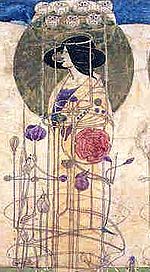
George Henry Walton
George Henry Walton , was a noted Scottish architect and designer of remarkable diversity. George was the youngest of twelve talented children of Jackson Walton, a Manchester commission agent and himself an accomplished painter and photographer, by his second wife, the Aberdeen-born Quaker Eliza...
set up George Walton & Co, Ecclesiastical and House Decorators on the basis of his 1888 commission from Kate Cranston, and in 1896 was commissioned by her to design the interiors of new tearooms, designed and built by George Washington Browne
George Washington Browne
Sir George Washington Browne FRIBA was a Scottish architect. He was born in Glasgow, and trained there and in London...
of Edinburgh
Edinburgh
Edinburgh is the capital city of Scotland, the second largest city in Scotland, and the eighth most populous in the United Kingdom. The City of Edinburgh Council governs one of Scotland's 32 local government council areas. The council area includes urban Edinburgh and a rural area...
, at 91-93 Buchanan Street
Buchanan Street
Buchanan Street is one of the main shopping thoroughfares in Glasgow, the largest city in Scotland. It forms the central stretch of Glasgow's famous shopping district with a generally more upmarket range of shops than the neighbouring streets: Argyle Street, and Sauchiehall Street.-History:...
, which opened the following year. He was assisted in this by Charles Rennie Mackintosh
Charles Rennie Mackintosh
Charles Rennie Mackintosh was a Scottish architect, designer, watercolourist and artist. He was a designer in the Arts and Crafts movement and also the main representative of Art Nouveau in the United Kingdom. He had a considerable influence on European design...
who designed wall mural
Mural
A mural is any piece of artwork painted or applied directly on a wall, ceiling or other large permanent surface. A particularly distinguishing characteristic of mural painting is that the architectural elements of the given space are harmoniously incorporated into the picture.-History:Murals of...
s in the form of stencil
Stencil
A stencil is a thin sheet of material, such as paper, plastic, or metal, with letters or a design cut from it, used to produce the letters or design on an underlying surface by applying pigment through the cut-out holes in the material. The key advantage of a stencil is that it can be reused to...
led frieze
Frieze
thumb|267px|Frieze of the [[Tower of the Winds]], AthensIn architecture the frieze is the wide central section part of an entablature and may be plain in the Ionic or Doric order, or decorated with bas-reliefs. Even when neither columns nor pilasters are expressed, on an astylar wall it lies upon...
s depicting opposing pairs of elongated female figures surrounded by roses for the ladies’ tearoom, the luncheon room and the smokers’ gallery.
- "It is believed (and averred) that in no other town can you see in a place of refreshment such ingenious and beautiful decorations in the style of the new art as in Miss Cranston's shop in Buchanan Street. Indeed, so general in the city is this belief that it has caused the Glasgow man of the better sort to coin a new adjective denoting the height of beauty... 'It's quite Kate Cranston-ish !' "
Kate Cranston expanded her first tearoom to take over the whole building at 114 Argyle Street and commissioned Walton to design a new more modern interior, which opened in 1898. Walton's work included fireplaces, stencilled wall murals and stained glass panels for the doors. In the luncheon room the murals and door panels had a rose pattern theme. The furniture was designed by Mackintosh, introducing for the first time his characteristic high-backed chairs.
In 1900 Kate Cranston gave Mackintosh the opportunity to redesign an entire room, at the Ingram Street tearoom. He had just recently married the artist Margaret MacDonald
Margaret MacDonald (artist)
Margaret MacDonald Mackintosh was a Scottish artist whose design work became one of the defining features of the "Glasgow Style" during the 1890s....
, and together they created the White Dining Room, including a hallway opening onto the street and divided off by a wooden screen with leaded glass
Stained glass
The term stained glass can refer to coloured glass as a material or to works produced from it. Throughout its thousand-year history, the term has been applied almost exclusively to the windows of churches and other significant buildings...
panels, giving those entering glimpses into the room itself. His fame was spreading, and in 1902 The Studio wrote of "Miss Cranston, whose tea-rooms, designed by Mr. Mackintosh, are reckoned by some of the pilgrims to Glasgow as one of the sights of the city."
The Willow Tearooms
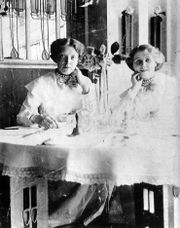
In a humorous review of the new tearoom for the Glasgow Evening News titled Erchie in an Art Tea Room, Neil Munro
Neil Munro (Hugh Foulis)
Neil Munro was a Scottish journalist, newspaper editor, author and literary critic. He was born in Inveraray and worked as a journalist on various newspapers....
described the "Room de Looks":
-
-
-
-
-
- "The chairs is no like ony ither chairs ever I clapped eyes on, but ye could easy guess they were chairs, and a' roond the place there's a lump o' looking-gless wi' purple leeks pented on it every noo and then."
-
-
-
-
In 1905 Dekorative Kunst
Dekorative Kunst
Dekorative Kunst was a German avant-garde art magazine published from 1897 to 1929. The magazine promoted the Jugendstil or Art Nouveau style and was founded by Julius Meier-Graefe....
featured a special issue about the Willow Tea Rooms written by Hermann Muthesius
Hermann Muthesius
Adam Gottlieb Hermann Muthesius , known as Hermann Muthesius, was a German architect, author and diplomat, perhaps best known for promoting many of the ideas of the English Arts and Crafts movement within Germany and for his subsequent influence on early pioneers of German architectural modernism...
who advised that "Today any visitor to Glasgow can rest body and soul in Miss Cranston's Tea Rooms and for a few pence drink tea, have breakfast and dream that he is in fairy land."
Further projects

Nitshill
Nitshill is a district on the south side of Glasgow. It is north of South Nitshill, south of Crookston, and southwest of Silverburn and Pollok. Nitshill was originally a coal mining village...
which was home to herself and her husband John Cochrane.
Mackintosh carried out further work on the Argyle Street tearoom in 1906 to design a basement conversion to form The Dutch kitchen. He did further redesigns for rooms in the Ingram Street tearooms, creating the Cloister Room and the Chinese Room in 1911. The latter provides an exotic fantasy, with bright blue finished timber screens incorporating a cashier's kiosk, elaborate door lintels and dark blue finished furniture, all in Mackintosh's version of an oriental style.
In the same year Kate Cranston provided temporary "Exhibition Cafes" at the Scottish International Exhibition, apparently set up and designed by Charles Rennie Mackintosh, though nothing is now known of his scheme for this. The menu card designed by Margaret MacDonald Mackintosh
Margaret MacDonald (artist)
Margaret MacDonald Mackintosh was a Scottish artist whose design work became one of the defining features of the "Glasgow Style" during the 1890s....
shows the name for the tearooms, The White Cockade
Cockade
A cockade is a knot of ribbons, or other circular- or oval-shaped symbol of distinctive colors which is usually worn on a hat.-Eighteenth century:...
, but makes no visual connection with this reference to Jacobitism
Jacobitism
Jacobitism was the political movement in Britain dedicated to the restoration of the Stuart kings to the thrones of England, Scotland, later the Kingdom of Great Britain, and the Kingdom of Ireland...
. It gives credit for supply of cakes to Miss Cranstons Bakery, 292 St Vincent St., Glasgow.

James Miller (architect)
James Miller was a Scottish architect and artist. He is noted for his many buildings in Glasgow and for his Scottish railway stations. Among these are the heavily American-influenced Union Bank building at 110-20 St Vincent Street; his 1901-1905 extensions to Glasgow Central railway station; and...
, occupying the third floor of a six-storey building in Renfield Street, Glasgow.
In 1917 Mackintosh carried out his last commission for Kate Cranston, and indeed one of his last architectural works to be constructed, with the design of an extension of the Willow Tea Rooms into the basement of the building next door to create The Dug Out in a style that anticipated Art Deco
Art Deco
Art deco , or deco, is an eclectic artistic and design style that began in Paris in the 1920s and flourished internationally throughout the 1930s, into the World War II era. The style influenced all areas of design, including architecture and interior design, industrial design, fashion and...
.
Kate Cranston was greatly distressed when her husband died in 1917. She sold off her tea rooms and other businesses, and withdrew from public life. She had no children, and when she died in 1934 her will left two thirds of her estate to the poor of Glasgow.
Legacy
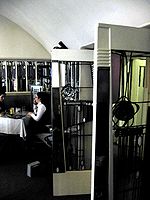
The Willow Tearooms were renamed, then in 1928 they were sold on to Daly's department store who incorporated the premises into their shop, keeping the Room de Luxe in operation as the department store tea room.
Miss Cranston's Tearooms on Ingram Street continued in use as catering facilities from 1930 for Cooper's & Co., then in 1950 the rooms came into the ownership of Glasgow City Council and were used for storage and a souvenir shop. In 1971 the furnishings were removed into storage when the building was demolished, and they are now the only original set of Mackintosh tearoom interiors to survive. Ownership was transferred to Glasgow Museums in 1978, and after a further period of storage restoration work began in 1993. The Ladies' Luncheon Room was exhibited three years later, and the Chinese Room and Cloister Room have since been restored. The Glasgow Museums website reports that they are "currently assessing what will be needed to research and preserve the Charles Rennie Mackintosh interiors of the Ingram Street Tearooms for future public display."
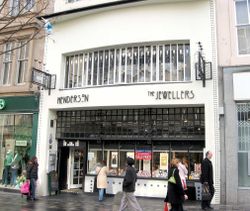
Modern architecture
Modern architecture is generally characterized by simplification of form and creation of ornament from the structure and theme of the building. It is a term applied to an overarching movement, with its exact definition and scope varying widely...
, particularly in terms of the exterior of the Willow Tea Rooms. In the 1960s a resurgence of interest in Art Nouveau
Art Nouveau
Art Nouveau is an international philosophy and style of art, architecture and applied art—especially the decorative arts—that were most popular during 1890–1910. The name "Art Nouveau" is French for "new art"...
brought him international fame, and the furniture and designs he and his wife created for Kate Cranston are now extremely valuable.
When Daly's closed, the Willow Tea Rooms were restored to an approximation of their original appearance. Catering reopened in the Room de Luxe, later extending to the recreated Tea Gallery, and was so successful that the business opened a new tearoom on the first floor of a building in Buchanan Street, near the original Buchanan Street and Ingram Street tearooms, fitted out with replicas of the White Dining Room and the Chinese Room from the Ingram Street tearoom. Confusingly, it trades under the name of The Willow Tea Rooms, as this now appears to be more familiar to visitors than Miss Cranston's name.
However, these new tearooms draw renewed attention to the contribution Kate's patronage made to Mackintosh's work, and the impact she had on the social life of Glasgow is still remembered in popular books such as Tea at Miss Cranston's.

